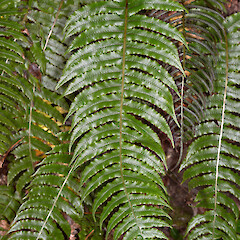Cranfillia deltoides
Common name
korokio, mountain hard fern
Synonyms
Lomaria vulcanica Blume; Spicanta vulcanica (Blume) Kuntze; Lomaria deflexa Colenso; Lomaria deltoides Colenso; Lomaria paucijuga Colenso; Blechnum vulcanicum (Blume) Kuhn; Cranfillia vulcanica (Blume) Gasper et V.A.O.Dittrich; Blechnum deltoides (Colenso) T.C.Chambers
Family
Blechnaceae
Flora category
Vascular – Native
Endemic taxon
No
Endemic genus
No
Endemic family
No
Structural class
Ferns
NVS code
The National Vegetation Survey (NVS) Databank is a physical archive and electronic databank containing records of over 94,000 vegetation survey plots - including data from over 19,000 permanent plots. NVS maintains a standard set of species code abbreviations that correspond to standard scientific plant names from the Ngä Tipu o Aotearoa - New Zealand Plants database.
BLEVUL
Chromosome number
2n=68
Current conservation status
The conservation status of all known New Zealand vascular plant taxa at the rank of species and below were reassessed in 2017 using the New Zealand Threat Classification System (NZTCS) – more information about this can be found on the NZTCS website. This report includes a statistical summary and brief notes on changes since 2012 and replaces all previous NZTCS lists for vascular plants.
Please note, threat classifications are often suggested by authors when publications fall between NZTCS assessment periods – an interim threat classification status has not been assessed by the NZTCS panel.
- Conservation status of New Zealand indigenous vascular plants, 2017 . 2018. Peter J. de Lange, Jeremy R. Rolfe, John W. Barkla, Shannel P. Courtney, Paul D. Champion, Leon R. Perrie, Sarah M. Beadel, Kerry A. Ford, Ilse Breitwieser, Ines Schönberger, Rowan Hindmarsh-Walls, Peter B. Heenan and Kate Ladley. Department of Conservation. Source: NZTCS and licensed by DOC for reuse under the Creative Commons Attribution 4.0 International licence.
2017 | Not Threatened | Qualifiers: SO
Previous conservation statuses
2012 | Not Threatened
2009 | Not Threatened
2004 | Not Threatened
Distribution
Indigenous. New Zealand: North Island (uncommon north of Auckland), South Island, Stewart Island/Rakiura, Chatham Islands. Also South-eastern Australia.
Habitat
Coastal to montane. Usually in forested areas on cliff faces, rock outcrops, banks (especially roadside banks) and, less commonly on boulders and rocks along stream beds and in open forest.
Detailed description
Rhizome creeping to erect, sometimes forming a small trunk. Fronds dimorphic, 0.01–0.68 m long, 30–100 mm wide. Stipe 90–360 mm long, stramineous to brown; scales linear to narrowly triangular, acuminate, entire, dark red-brown, with straight white hairs at least at base of stipe. Lamina narrowly triangular, pinnatisect or pinnate, with 6–30 or more pairs of pinnae; rachis and costae stramineous to brown, ± glabrous; sterile pinnae oblong to narrowly triangular, weakly falcate, acuminate, 32–80 × 8–10 mm, often pilosa, adnate; margins crenate; basal pinnae broader, falcate, deflexed, not adnate basiscopically; fertile pinnae 30.0–45.0 × 2.0–3.5 mm.
Similar taxa
None. Easily recognised by the creeping growth habit, rather narrow, deltoid, harsh textured (often crinkly) sterile fronds, and by the distinctive deflexed basal pinnae.
Flowering
N.A.
Flower colours
No flowers
Fruiting
N.A.
Propagation technique
Often fickle. Does better in cooler climates, preferring a shaded site panted in damp, rich, free draining soil. Dislikes competition.
Etymology
deltoides: From the Greek ‘delta’ the third letter of the alphabet and referring to three-sided shapes such as triangular or delta-shaped
Taxonomic information
Perrie et al. (2014) advocated for a broadened circumscription of Blechnaceae whereby a number of genera traditionally recognised as distinct from Blechnum were merged within it. However, this view has not met with universal acceptance (see Gasper et al. 2016) and does not seem to be followed worldwide (PPG 2016). From a New Zealand perspective, the decision to merge Doodia in Blechnum, and rejection of Diploblechnum has not been universally accepted either (e.g., Wilcox & Warden (2017)), and as such it is considered appropriate to follow world opinion and accept the taxonomy of Gasper et al. (2016) and recommendations of the PPG (2016).
Chambers & Wilson (2019) revised the Blechnum vulcanicum complex, electing to use Blechnum in preference to Cranfillia because this was ‘favoured by the senior author’. In their revision they treated the widespread New Zealand and South-eastern Australian plants previously referred to as Blechnum vulcanicum or Cranfillia vulcanica as Blechnum deltoides (based on Lomaria deltoides Colenso). To accommodate this species in Cranfillia de Lange & Parris (2019) made the necessary combination for it, as Cranfillia deltoides.
Attribution
Fact sheet prepared for NZPCN by P.J. de Lange (19 September 2012). Description adapted from Chambers & Farrant (1998).
References and further reading
Chambers TC, Farrant PA. 1998. Blechnaceae. Flora of Australia 48, Ferns Gymnosperms and allied groups: 359–384. ABRS/CSIRO Victoria, Australia.
Chambers TC, Wilson PG. 2019. A revision of Blechnum vulcanicum (Blume) Kuhn and related taxa (Blechnaceae) in Malesia and Oceania. Telopea 22: 41–59.
de Lange PJ, Parris B. 2019. New combinations in Cranfillia (Blechnaceae: Polypodiopsida) for recent segregates of the Blechnum vulcanicum complex. Telopea 22: 153–156.
Gasper AL, de Oliveira Dittrich VA, Smith AR, Salino A. 2016. A classification for Blechnaceae (Polypodiales: Polypodiopsida): New genera, resurrected names, and combinations. Phytotaxa 275: 191–227. https://doi.org/10.11646/phytotaxa.275.3.1.
Perrie LR, Wilson RK, Shepherd LD, Ohlsen DJ, Batty EL, Brownsey PJ, Bayly MJ. 2014. Molecular phylogenetics and generic taxonomy of Blechnaceae ferns. Taxon 63(4): 745–758. https://doi.org/10.12705/634.13.
PPG 1: The Pteridophyte Phylogeny Group 2016. A community-derived classification for extant lycophytes and ferns. Journal of Systematics and Evolution 54: 563–603. https://doi.org/10.1111/jse.12229.
Wilcox M, Warden J. 2017. Botany of Hillsborough coast bush reserves, Manukau Harbour, Auckland. Auckland Botanical Society Journal 72: 32–46.
NZPCN Fact Sheet citation
Please cite as: de Lange, P.J. (Year at time of access): Cranfillia deltoides Fact Sheet (content continuously updated). New Zealand Plant Conservation Network. https://www.nzpcn.org.nz/flora/species/cranfillia-deltoides/ (Date website was queried)













